Shark Ecomorphotypes
Sharks that inhabit a given habitat type often converge on a suite of similar adaptations, regardless of ancestry. Due to this convergence, sharks that inhabit a particular niche are usually similar in overall morphology and behavior. Thus, the 390 or so described shark species may be grouped into a smaller number of discrete categories based on their ecological-morphological type or "ecomorphotype". The sharks grouped within a given ecomorphotype may or may not be evolutionarily closely related, but they are related by common features of form and habits.
A system of ecomorphotypes embracing all known cartilaginous fishes, both extant and extinct, has been proposed by Leonard J.V. Compagno. But many of his categories are irrelevant to sharks, while others contain redundancies or inconsistencies of form. The system of ecomorphotypes I employ here is based on this previous work, but seems to 'better' fit habitat diversity of extant sharks, providing a useful way of grouping these animals by commonalties in their ecological adaptations. Eighteen ecomorphotype categories are defined and described below; a condensed summary of each category — with examples drawn mostly from species profiled elsewhere in these pages — are presented below.
Continental and Insular Shelves
The greatest diversity of shark ecomorphotypes occurs on continental and insular shelves. These coastal sharks can be divided into 10 ecomorphotypes by tropic (feeding) habits and adaptations to a benthis (bottom-dwelling) mode of life.
Mesotrophic Littoral - these are unspecialized active coastal sharks, highly successful generalist predators adept at exploiting a wide range of prey resources. Most of them have generalized dentition and are primarily piscivorous, but they also take a variety of crustaceans, molluscs, and other small- to medium-sized creatures. The sharks grouped here are typically medium-sized (5 to 7 feet or 1.5 to 2.1 metres in length) and are often quick and agile hunters, collectively comprising the majority of living shark species. The hammerheads (family Sphyrnidae) feature unique lateral expansions on the sides of the head that grant some significant sensory and hydrodynamic benefits, such as enhanced scent-tracking, electroreception, and maneuverability, at the cost of some jaw protrusibility.
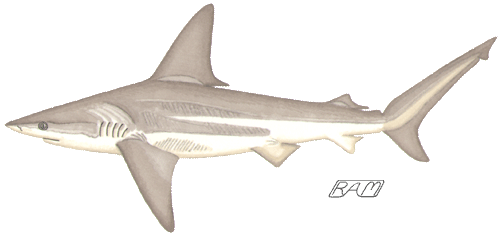
Sandbar Shark (Carcharhinus plumbeus)
Examples: Spiny Dogfish (Squalus acanthias), Sandtiger Shark (Carcharias taurus), Silvertip Shark (Carcharhinus albimarginatus), Grey Reef Shark (Carcharhinus amblyrhynchos), Bronze Whaler (Carcharhinus brachyurus), Galapagos Shark (Carcharhinus galapagensis), Blacktip Shark (Carcharhinus limbatus), Blacktip Reef Shark (Carcharhinus melanopterus), Caribbean Reef Shark (Carcharhinus perezi), Sandbar Shark (Carcharhinus plumbeus), Sharptooth Lemon Shark (Negaprion acutidens), Lemon Shark (Negaprion brevirostris), Scalloped Hammerhead (Sphyrna lewini), Great Hammerhead (Sphyrna mokarran), Whitetip Reef Shark (Triaenodon obesus)
Tueuthotrophic Littoral - these are active coastal sharks specializing in cephalopod prey. Cephalopods, including octopuses, squids, and cuttlefishes, are soft-bodied and jet-propelled, making them difficult to capture. Members of this ecomorphotype are typically smallish (3- to 5-foot or 1 to 1.5-metre) and are characterized by comb-like upper teeth, small spike-like lower teeth, and a small, short mouth that is well suited to forming a powerful pharyngeal suction. The Sicklefin Smoothhound Shark (Hemigaleus microstoma) may have the most specialized diet of any shark, as fully 98% of its diet consists of cephalopods, primarily octopuses. The Tawny Shark (Nebrius ferrigineus) is a coastal cephalopod-specialist that shares the small, short mouth but is is exceptionally large (to 10 feet or 3 metres) and possesses comb-like upper and lower dentition.

Tawny Nurse Shark (Nebrius ferrugineus)
Examples: Tawny Nurse Shark (Nebrius ferrugineus), Wiskery Shark (Furgaleus macki), Sicklefin Weasel Shark (Hemigaleus microstoma)
Cancritrophic Littoral - these are active coastal sharks specializing in crustacean prey. Crustaceans feature hard chitinous shells, often strengthened with calcium salts, making them difficult to crush and eat. Members of this ecomorphotype are typically small- to medium-sized (3- to 5-foot or 1 to 1.5-metre) and are characterized by small, pebble-like or stout multi-cusped dentition and a small, short mouth that — like those of Teuthotrophic Littoral sharks — is well suited to forming a powerful pharyngeal suction. The Leopard Shark (Triakis semifasciata) and Bonnethead Shark (Sphyrna tiburo) possess small, blade-like teeth that enable them to feed on such prey as polychaete worms and small fishes in addition to crustaceans. The Zebra Shark (Stegostoma varium) and Nurse Shark (Ginglymostoma cirratum) are unusually large, growing to lengths of more than 7 feet (2.1 metres)

Zebra Shark (Stegostoma varium)
Examples: Zebra Shark (Stegostoma varium), Nurse Shark (Ginglymostoma cirratum), Swell Shark (Cephaloscyllium ventriosum), Gummy Shark (Mustelus antarcticus), Leopard Shark (Triakis semifasciata), Tope Shark (Galeorhinus galeus), Bonnethead Shark (Sphyrna tiburo)
Durotrophic Littoral - these are active coastal sharks specializing in particularly hard- or tough-shelled prey, such as clams, oysters, and sea urchins. Members of this ecomorphotype are typically smallish (3- to 5-foot or 1 to 1.5-metre) and feature short, heavily calcified and thickly-muscled jaws armed with stout, sturdy nutcracker-like dentition. Adult bullhead sharks (family Heterodontidae) feature conical, sometimes multi-cusped, grasping teeth at the front of the mouth and flat, molar-like teeth at the rear, which are well-suited to crushing the hard, calcareous shells of their prey.
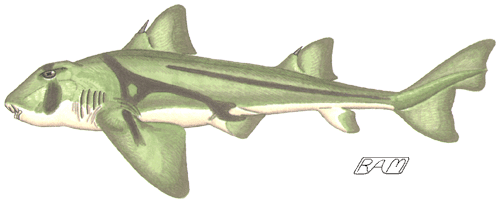
Port Jackson Shark (Heterodontus
portusjacksoni)
Examples: Horn Shark (Heteodontus francisci), Port Jackson Shark (Heterodontus portusjacksoni)
Microtrophic Littoral - there are large to gigantic, slow-swimming coastal sharks that sift minute prey from the water via specialized filters located in the gill region. Members of this ecomorphotype routinely grow to lengths of more than 16 feet (5 metres) and feature a large, nearly terminal mouth, greatly reduced dentition, and large to enormous gill slits. The filter system of the mesopelagic Megamouth Shark (Megachasma pelagios) and the cool temperate Basking Shark (Cetorhinus maximus) consists of modified gill rakers, while that of the tropical Whale Shark (Rhincodon typus) — which grows to lengths of 50 feet (15 metres), making it the largest living shark — consists of spongy plates between the gill bars which are better suited to filtering tiny warm-water plankton. The Basking Shark relies on ram-ventilation to filter-feed, while the Whale Shark and — to a lesser extent — the Megamouth Shark also employ suction-feeding.
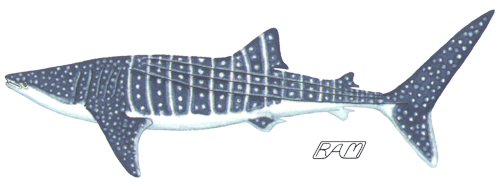
Whale Shark (Rhincodon typus)
Examples: Whale Shark (Rhincodon typus), Megamouth Shark (Megachasma pelagios), Basking Shark (Cetorhinus maximus)
Eurytrophic Littoral - these are large to gigantic coastal sharks that feed on a wide variety of marine animals, taking even very large prey such as marine mammals and other sharks. Members of this ecomorphotype are large as adults, ranging from 10 to more than 16 feet (3 to more than 5 metres) in length, and feature proportionately large, often heavily calcified jaws armed with large, broad, and serrated teeth that are well-suited to sawing bite-sized hunks from large food items. They are highly opportunistic and particularly prone to scavenging. The Broadnose Sevengill Shark (Notorynchus cepedianus) is somewhat unusual in that its upper teeth have slender, smooth-edged cusps better suited to grasping prey small enough to be swallowed whole, but its broad, multi-cusped lower teeth apparently enable it to saw apart large food items. The dentition of the Tiger Shark (Galeocerdo cuvier) features a large primary notch and a coarsely serrated rear margin, which enable it to puncture and rip through the hard shells of sea turtles.

Tiger Shark (Galeocerdo cuvier)
Examples: Broadnose Sevengill Shark (Notorynchus cepedianus), White Shark (Carcharodon carcharias), Tiger Shark (Galeocerdo cuvier), Bull Shark (Carcharhinus leucas)
Mesobenthic Littoral - these are unspecialized, bottom-dwelling coastal sharks. Members of this ecomorphotype are typically smallish (3- to 5-foot or 1 to 1.5-metre), somewhat flattened sharks that feed primarily on benthic invertebrates, such as polychaete worms, and crustaceans, but also take small bottom-associated teleost fishes. They feature a relatively small mouth armed with a generalized grasping/crushing dentition that is well suited to capturing and processing a variety of small bottom-dwelling prey animals.

Small-Spotted Catshark (Scyliorhinus canicula)
Examples: Blind Shark (Brachylurus waddi), Pyjama Catshark (Poroderma africanum), Small-Spotted Catshark (Scyliorhinus canicula)
Leptobenthic Littoral - these are elongated, bottom-dwelling coastal sharks, which typically hunt within the tight confines of crevices and grottos penetrating coral and rocky reefs. Members of this ecomorphotype are smallish (averaging about 3 feet or 1 metre in length) and are characterized by a slender, elongated body with highly mobile pectoral and pelvic fins, which are used like 'legs' to clamber over the bottom and crawl through confines spaces within reefs. They typically feature a small mouth armed with a generalized grasping/crushing dentition that — like that of the Mesobenthic Littoral sharks — is well suited to capturing and processing a variety of small bottom-dwelling prey animals. At low tide, the Epaulette Shark (Hemiscyllium ocellatum) uses its highly mobile paired fins to clamber from tidepool to tidepool, hunting for small prey that has been trapped by the receding tide.

Epaulette Shark (Hemiscyllium ocellatum)
Examples: Necklace Carpetshark (Parascyllium variolatum), White-Spotted Bambooshark (Chiloscyllium plagiosum), Epaulette Shark (Hemiscyllium ocellatum), Speckled Catshark (Halaelurus boesmani)
Platybenthic Littoral - these are flattened, bottom-dwelling coastal sharks that are cryptic, often lying-in-wait for unwary prey to blunder within striking range. Members of this ecomorphotype are typically medium-sized sharks (averaging 5 to 7 feet or 1.5 to 2.1 metres in length) featuring a proportionately large mouth, slender, smooth-edged grasping teeth, enlarged pectoral and pelvic fins, reduced gill openings, and powerful throat and gill muscles that help create a strong suction to hoover up prey. Wobbegongs (family Orectolobidae) sport elaborately variegated patterns on the back and the outline of the head is obscured by a 'beard' of fleshy tassels. Angelsharks (Squatinidae) are typically less elaborately patterned and lack fleshy tassels along the sides of the head, relying instead on partial burial to provide camouflage. When a suitably-sized prey animal approaches close enough, angel sharks explosively raise the anterior portion of the body off the bottom and extend their bear-trap like jaws in what is termed a "snap-up attack".
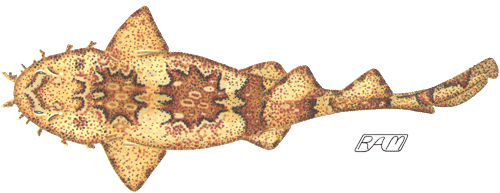
Ornate Wobbegong (Orectolobus ornatus)
Examples: Pacific Angelshark (Squatina californica), Tasseled Wobbegong (Eucrossorhinus dasypogon), Spotted Wobbegong (Orectolobus maculatus), Ornate Wobbegong (Orectolobus ornatus)
Pristobenthic Littoral - these are saw-bearing, bottom-dwelling coastal sharks in which the rostrum (snout) is flattened and elongated, armed along both sides with tooth-like projections that alternate in length. Members of this ecomorphotype are smallish sharks (about 5 feet or 1.5 metres in length) and — in addition to the rostral saw — feature flattened bodies, lack of an anal fin, a poorly developed lower caudal lobe, a pair of touch-sensitive barbels located about mid-way on the undersurface of the saw, and a skull with enlarged processes on the posterior end, providing firm attachments for the muscles that swing the saw side-to-side when impaling or incapacitating prey. Presumably to make birth easier on their mothers, sawsharks (family Pristiophoridae) are born with their long rostral teeth folded back along the saw; the shorter rostral teeth grow in after birth.

Longnose Sawshark (Pristiophorus cirratus)
Examples: Sixgill Sawshark (Pliotrema warreni), Longnose Sawshark (Pristiophorus cirratus)
Open Ocean
The open ocean, due to its enormous expanse and relatively low productivity compared with continental shelf waters, is a difficult habitat for most sharks. As a consequence, shark diversity in this habitat is relatively low and can be divided into three ecomorphotypes.
Macropelagic - these are large oceanic sharks that cruise slowly but are capable of rapid bursts of acceleration. Members of this ecomorphotype range from 10 to almost 20 feet (3 to almost 6 metres) in length and typically feature a well-streamlined body, large eyes, large jaws armed with moderate- to large-sized teeth, relatively long, falcate or semifalcate pectoral fins, a deeply forked tail with well developed lower lobe. They are generally active swimmers with serrated teeth that take relatively large, fairly speedy prey. Thresher sharks (family Alopiidae) feature smooth-edged teeth and a caudal fin with a hyperextended upper lobe which they apparently use to stun small schooling fishes and squids. The Longfin Mako (Isurus paucus) also has smooth-edged, knife-like teeth and many features with the fast-swimming sharks of the family Lamnidae, yet appears to feed on relatively small, slow-swimming prey. Young Silky Sharks (Carcharhinus falciformis) remain over continental margins, but adults of this species range far into the open ocean and well away from land.
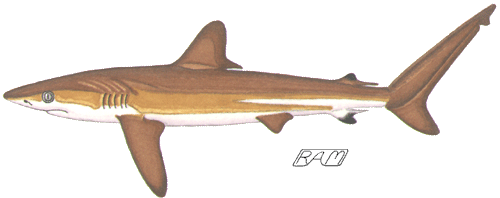
Silky Shark (Carcharhinus falciformis)
Examples: Common Thresher (Alopias vulpinus), Bigeye Thresher (Alopias superciliosus), Longfin Mako (Isurus paucus), Silky Shark (Carcharhinus falciformis), Oceanic Whitetip Shark (Carcharhinus longimanus), Blue Shark (Prionace glauca)
Micropelagic - these are tiny to small oceanic sharks, most of which are inhabitants of the mesopelagic, spending daylight hours at depth and migrating surfaceward at night. Members of this ecomorphotype are usually between 6 inches and 4 feet (15 centimetres and 1.2 metres) long and typically feature a long, cylindrical body, large eyes, a bulbous snout, a large oily liver, relatively small fins and a tendency toward a caudal fin shape that is symmetrical or nearly so. Many are bioluminescent, including the Taillight Shark (Euprotromicroides xantedeschia) — which squirts bluish glowing goo from its cloaca, probably to startle predators — and the Cookiecutter Shark (Isistius brasiliensis) — which lures large pelagic animals toward it, which it then parasitizes by using its sawband-like lower teeth to scoop out a plug of flesh. Most of the Micropelagic sharks are squaloids, but the Crocodile Shark (Pseudocarcharias kamoharai) is a lamnoid and also non-bioluminescent.

Cookiecutter Shark (Isistius brasiliensis)
Examples: Spined Pygmy Shark (Squaliolus laticaudus), Taillight Shark (Euprotromicroides zantedeschia), Cookiecutter Shark (Isistius brasiliensis), Crocodile Shark (Pseudocarcharias kamoharai)
Tachypelagic - these are large, fast-swimming oceanic sharks adopting a high-energy lifestyle, facilitated by a modified circulatory system that enables them to maintain elevated body temperatures. Members of this ecomorphotype measure 10 to 13 feet (3 to 4 metres) as adults and feature a highly streamlined body, conical snout, large, dark eyes, a large mouth armed with large, unserrated, knife-like teeth, large gills, a narrow tail stalk supported by horizontal keels, and a lunate caudal fin. They are high-speed cruisers capable of tremendous bursts of acceleration, often leaping completely out of the water. The Shortfin Mako (Isurus oxyrinchus) is capable of sprints of 50 miles (90 kilometres) per hour or more, making it the fastest of all sharks.
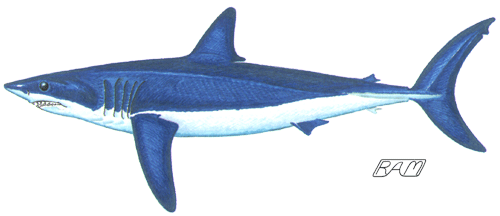
Shortfin Mako (Isurus oxyrinchus)
Examples: Salmon Shark (Lamna ditropis), Porbeagle (Lamna nasus), Shortfin Mako (Isurus oxyrinchus)
Continental and Insular Slopes
The continental and insular slopes, where the ocean bottom falls away from the the shelves of landmasses and islands, is where the true ocean depths begin. Despite their nutrient-starved slopes, a diverse assemblage of sharks is associated with bathic (deep-sea bottom) habitats.
Mesobathic - these are small to large (typically 1 to 10 feet or 30 centimetres to 3 metres in length) unspecialized deep-sea sharks, comprising the bulk of shark diversity on or just above the bottom at moderately great depths (less than 10,000 feet or 3,000 metres). Members of this ecomorphotype are relatively inactive compared with littoral sharks and feature soft skin, large rough dermal denticles, flaccid muscles, and weak calcification of the skeleton. They are further characterized by a long trunk and body cavity, filled with a huge, enormously oily liver, and are often colored grey to black or chocolate-brown. Many shark species that typically inhabit deep bottom habitats near the equator invade shallow benthic habitats at high latitudes. Examples include the small, bioluminescent Velvet Belly (Etmopterus spinax) — which grows to a length of about a foot (30 centimetres) in length and has been photographed by a diver in a Norwegian fjord — the large Bluntnose Sixgill Shark (Hexanchus griseus) — which grows to a length of about 16 feet (5 metres) and which seasonally enters shallow coastal waters in the Pacific Northwest — and the very large Greenland Shark (Somniosus microcephalus) — which reaches lengths of more than 20 feet (6 metres) and has successfully invaded coastal waters in the High Arctic. These sharks thus neatly bridge the ecological gap between the Mesobenthic and the Mesobathic ecomorphotypes.

Greenland Shark (Somniosus microcephalus)
Examples: Bluntnose Sixgill Shark (Hexanchus griseus), Portuguese Dogfish (Centroscymnus coelolepis), Velvetbelly Lanternshark (Etmopterus spinax), Greenland Shark (Somniosus microcephalus), Pacific Sleeper Shark (Somniosus pacificus), Angular Roughshark (Oxynotus centrina), Bumpytail Ragged-Tooth Shark (Odontaspis ferox), False Catshark (Pseudotriakis microdon)
Anguillobathic - these are eel-like deep-sea sharks represented by a single living species, the Frilled Shark (Chlamydoselachus anguineus). Its ecomorphotype is characterized by a very short, snake-like head, long, terminal jaws armed with tiny, trident-like teeth, an extremely elongated trunk and body cavity, filled with a large, very oily liver, a poorly calcified skeleton, and small fins. The pelvic fins, dorsal fin, and anal fin are located far posterior on the body and the caudal fin has a low thrust angle and a poorly developed lower lobe. This arrangement, combined with near neutral buoyancy, enables the Frilled Shark to 'float' nearly motionless in the water column and concentrates propulsive structures at the posterior end of the body, enabling it to strike, snake-like at its soft-bodied prey (which consists predominantly of mesopelagic squids). The elaborate frilly gill slits that give this species its common name may help move water over the gills while stationary in the water column or to create a pharyngeal suction to help capture prey.

Frilled Shark (Chlamydoselachus anguineus)
Example: Frilled Shark (Chlamydoselachus anguineus)
Cyranobathic - these are long-nosed deep-sea sharks. In addition to basic characteristics shared with Mesobathic sharks, members of this ecomorphotype feature an elongated head, paddle-like snout, protrusible jaws, soft skin, flabby muscles, poor skeletal calcification, a short trunk, and a short body cavity crammed with an oily liver. Most are deep-sea ghost catsharks (Apristurus spp.) measuring less than 3 feet (1 metre) in length and darkly colored in life, but the lamnoid Goblin Shark (Mitsukurina owstoni) grows to 11 feet (3.4 metres) and is pale pinkish-grey.

Goblin Shark (Mitsukurina owstoni)
Examples: Brown Catshark (Apristurus brunneus), Goblin Shark (Mitsukurina ostoni)
Anoxybathic - these are a small group of deep-sea sharks adapted to hypoxic (oxygen-poor) habitats. They sometimes inhabit hypoxic deep-water basins that also have high temperature and salinity, such as in the Santa Barbara Basin and the Red Sea. Members of this ecomorphotype are typically smallish (averaging about 1.5 feet or 50 centimetres in length) and, in addition to basic Mesobathic characteristics, feature elongated gill regions and expanded gill filaments which probably help them extract sufficient oxygen to carry out life processes from the hypoxic waters they inhabit. The group is limited to a few carcharhinoids, specifically certain pentanchine catsharks (the genera Parmaturus and probably Cephalurus) and some triakids (genus Iago). Little is known of their biology, life history, or behavior.
Examples: Lollipop Catshark (Cephalurus cephalus), Filetail Catshark (Parmaturus xaniurus), Bigeye Houndshark (Iago omanensis)
Freshwater
Freshwater habitats are osmotically difficult for sharks to invade, even briefly, and apparently very few species live in 'sweet water' full-time. It is uncertain that any extant shark actually completes its life cycle completely in fresh water, but one poorly-known genus of carcharhinid comes closer than any other.
Eurytrophic Eulittoral - these are omnivorous freshwater sharks that, in virtually every respect, closely resemble Eurytrophic Littoral sharks. Members of this ecomorphotype are very poorly known taxonomically and biologically, particularly how they adapt to the osmotic stresses imposed by their freshwater haunts or even whether or not they breed in fresh water. It is presumed that — like freshwater-adapted Bull Sharks (Carcharhinus leucas) — the Ganges River Shark (Glyphis gangeticus) and other spear-toothed sharks of the genus Glyphis feature body fluids with greatly reduced urea, sodium and chlorine ion concentrations, but this remains to be tested experimentally. Freshwater habitats are highly sensitive to human impacts, rendering these sharks highly vulnerable and in dire need of further research and conservation efforts.
Examples: Ganges River Shark (Glyphis gangeticus), spear-toothed sharks (Glyphis spp.)
